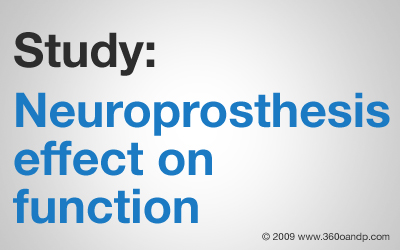
The Effect Of A New
Lower-limb Neuroprosthesis
On Physical And Social
Functioning
Jeffrey M. Hausdorff, Ph.D.
Division on Aging, HarvardMedicalSchool, Boston, MA
Haim Ring, M.D.
Loewenstein Rehabilitation Center, Ra’anna, Israel
Citation
Hausdorff J., Ring H, The Effect of a New Lower-Limb
Neuroprosthesis on Physical and Social Functioning. Abstract,
CSM 2007: Posters, Journal of Neurologic Physical Therapy,
2006:30(4) p207
Purpose/Hypothesis
To assess the effect of the NESS L300™, an FES based neuroprosthesis designed to ameliorate foot drop, on the physical and social functioning of patients with foot drop.
Number of Subjects
24 patients (mean age: 54.0 ± 13.5 yrs) with chronic hemiparesis (5.8 ± 5.2 yrs) whose walking was impaired by foot drop. 21 Patients were post stroke and 3 patients were
post traumatic brain injury (TBI).
Materials/Methods
Study design included baseline measurements followed by eight weeks of walking with a wireless FES neuroprosthesis designed to activate the ankle dorsiflexors synchronized with the gait cycle. Baseline measures included the social participation domain of the stroke impact scale (SIS-participation), the stroke impact scale-16 (SIS-16) to assess physical functioning, and a one week collection of physical activity data using step activity monitor (SAM, CYMA Inc). During week eight the same outcome measures were collected again representing a post test data collection. All patients signed informed consent approved by the Loewenstein Rehabilitation Center Institutional Review
Board (IRB).
Results
Wilcoxon signed-ranks test was used separately for each questionnaire. Significant improvement in the social participation score (p=0.008) and the SIS-16 score (p=0.003) were found after eight weeks of walking with the NESS L300™. Comparing the number of steps with the NESS L300™ and without it revealed an increase of 18% in the number of steps (p<0.001), representing an improvement in the physical activity. In addition, a Spearman’s correlation between the number of steps while using the neuroprosthesis and the SIS-participation at the end of the study was significant (r=0.51, p=0.012), demonstrating the positive association between these two parameters.
Conclusions
Chronic stroke and traumatic brain injury survivors who walked with the NESS L300™ neuroprosthesis increased their community participation and physical functioning.
The significant association between physical activity and participation for this group of patients might indicate that when mobility improves an enhancement in social life can be expected.
Clinical Relevance
The present findings underscore the importance of using advanced FES technology in rehabilitation of stroke and TBI survivors, and provide an effective means for physical
therapists to advance the ambulation skills of these patients.
© 2006 Neurology Section, APTA.
NESS ® and NESS L300 ™ are trademarks of Bioness Neuromodulation Ltd
Ra’anana, Israel